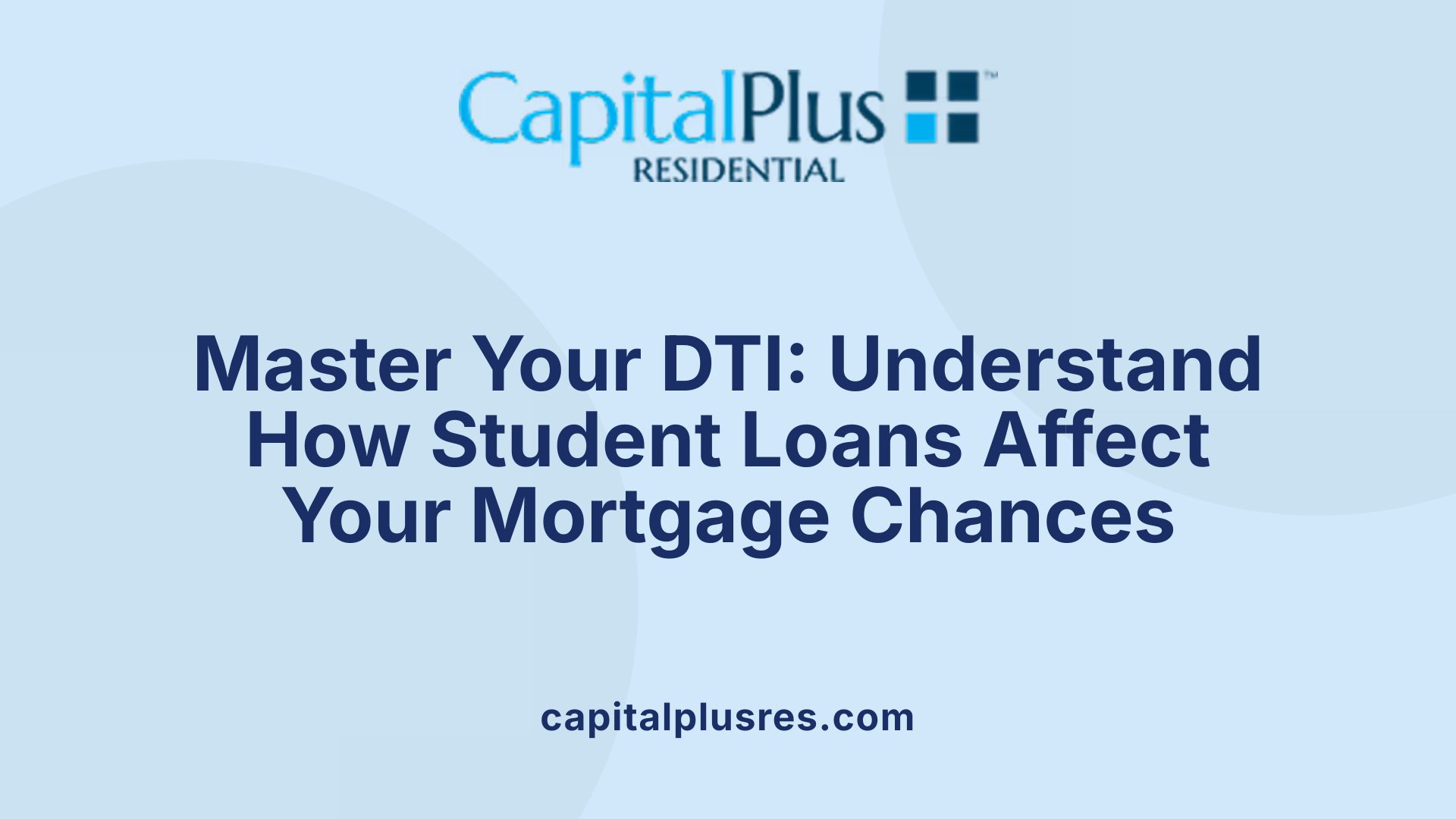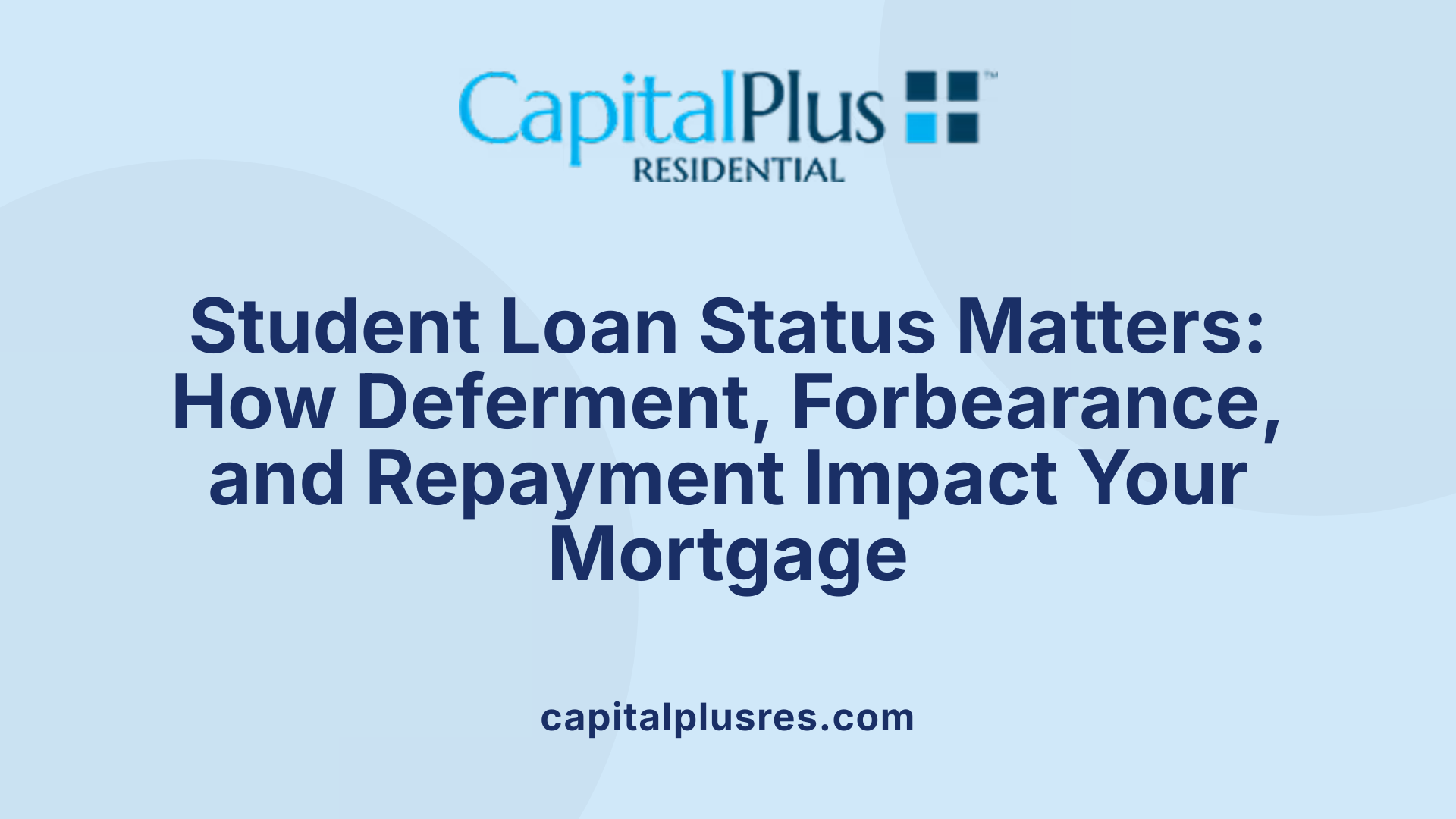Introducing the Challenge: Graduates, Student Debt, and Home Buying
Graduates today face a unique set of challenges when stepping into the housing market, largely due to the weight of student debt. This article explores mortgage strategies tailored specifically for recent graduates carrying student loan obligations, revealing how debt-to-income ratios, loan types, and repayment plans intersect with the path to homeownership.
Understanding Debt-to-Income Ratio and Its Impact on Mortgage Approval

What Is Debt-to-Income (DTI) Ratio?
The debt-to-income ratio, or DTI, is a measure lenders use to evaluate a borrower’s ability to manage monthly payments and repay debts. It compares the total monthly debt payments to the borrower's gross monthly income.
How Do Lenders Factor Student Loan Payments Into DTI?
Lenders include student loan payments as part of the borrower's monthly debts when calculating the back-end DTI ratio. Student loans can significantly affect this ratio, especially if monthly payments are high. This makes it harder for borrowers with large student loan debts to qualify for mortgages.
Front-End vs. Back-End DTI Ratios
Two DTIs are considered during mortgage approval:
- Front-End DTI: The percentage of income spent on housing costs (mortgage, taxes, insurance). Student loans are not included here.
- Back-End DTI: The percentage of income spent on all monthly debt payments, including student loans, credit cards, car loans, and housing costs.
Typical Maximum DTI Limits
Most lenders set the maximum allowed DTI around 43%, meaning total monthly debts should not exceed 43% of your gross monthly income. Some lenders may allow higher limits depending on the borrower's overall financial picture.
Impact of High DTI on Mortgage Eligibility
High student loan payments raise the back-end DTI, which can lower the chances of mortgage approval. However, new guidelines allow consideration of income-driven repayment plans, which can lower the effective student loan payment used in calculations. This helps borrowers improve their DTI and mortgage eligibility.
| Aspect | Description | Notes |
|---|---|---|
| DTI Definition | Ratio of debts to income | Important for assessing loan repayment ability |
| Student Loans & DTI | Included in back-end DTI | Can increase overall debt ratio, impacting approval |
| Front-End Ratio | Housing costs only | Student loans not counted here |
| Back-End Ratio | All monthly debts, including student loans | Critical for lender evaluations |
| DTI Limit | Usually 43%, some flexibility offered | Borrowers near or above this limit may face rejection |
| Impact on Approval | High DTI reduces chances | Income-driven plans can mitigate effect |
Understanding how your student loans affect your debt-to-income ratio is vital for successfully navigating the mortgage approval process.
Mortgage Program Options Designed for Borrowers With Student Debt

What mortgage options are available for buyers with student loans?
Several tailored mortgage programs support buyers managing student loan debt. Notably, Fannie Mae's HomeReady and Freddie Mac's Home Possible and HomeOne provide flexible qualification criteria considering student loan payments.
Government-backed loans like FHA, VA, and USDA also accommodate student borrowers distinctly. These programs often treat student loan payments differently based on repayment status — such as whether loans are in repayment, deferred, or in forbearance.
Eligibility nuances for each program
- Fannie Mae's HomeReady: Factors in actual student loan payments, including income-driven repayment plans, allowing for a more accurate debt-to-income (DTI) ratio assessment.
- Freddie Mac's Home Possible and HomeOne: Similar to HomeReady, these programs use actual payment amounts rather than a fixed percentage of loan balance, encouraging borrowers with deferred or low monthly student payments.
- FHA Loans: Typically use 0.5% of the student loan balance for DTI calculations when loans are deferred or in forbearance.
- VA Loans: Exclude deferred student loans from DTI ratio calculations, offering notable relief to eligible veterans.
- USDA Loans: Follow specific guidelines that consider student loan status to assess repayment capacity.
Accommodations for student loan statuses
Mortgage guidelines acknowledge different student loan scenarios to prevent unfair penalization:
- Deferred or Forbearance Status: FHA and conventional loans estimate payments at 0.5% of loan balances, but Fannie Mae and Freddie Mac allow use of actual income-driven payment amounts, sometimes even $0.
- Income-Driven Repayment Plans: Accepted widely across these programs, reducing monthly payment burdens in qualification calculations.
- Student Loans Eligible for Forgiveness: In some cases, loans that are on track for forgiveness may be excluded or treated differently during underwriting.
These specific accommodations are critical for borrowers aiming to qualify with large student debt, allowing for more realistic assessments of their ability to repay mortgages. Understanding these nuances can significantly enhance financing opportunities for homebuyers with student loans.
How Different Student Loan Statuses Affect Mortgage Calculations

How Do Lenders Treat Student Loans in Deferment or Forbearance When Assessing Mortgages?
When lenders assess mortgage applications, the status of student loans—whether they are in repayment, deferment, or forbearance—significantly impacts how loan payments factor into a borrower's debt-to-income (DTI) ratio.
Loans in Repayment, Deferment, and Forbearance
For student loans in active repayment, lenders typically use the actual monthly payment amount in DTI calculations. However, for loans in deferment or forbearance—where payments are postponed—standardized assumptions come into play.
FHA and Conventional Loans: Using 0.5% of Loan Balance
FHA and conventional mortgage guidelines often require lenders to use 0.5% of the outstanding student loan balance as the assumed monthly payment if the loan is deferred or in forbearance. This means even if no payment is being made temporarily, the borrower's income is considered against a calculated payment to ensure affordability.
VA Loans Excluding Deferred Student Loans
In contrast, VA loan guidelines recognize deferred student loans differently. They typically exclude these from the DTI calculation entirely. This exclusion can significantly improve a borrower's eligibility by lowering the calculated monthly debt payments and freeing up more of their income for mortgage qualification.
Differences in Monthly Payment Assumptions and Their Effects
Because mortgage programs vary in addressing student loan payments, understanding these distinctions is crucial. While FHA and conventional loans use a conservative 0.5% balance calculation for deferred loans, VA loans provide some relief by omitting these amounts. These approaches influence back-end DTI ratios and therefore affect mortgage approval chances.
Effect on Debt-to-Income and Mortgage Qualification
Student loans in deferment or forbearance still impact the borrower's back-end DTI ratio depending on the loan program used. Mortgage applicants should provide documentation showing loan status and actual payments. Showing enrollment in income-driven repayment plans with low or zero monthly payments can improve qualification prospects under updated guidelines from Fannie Mae and Freddie Mac, which accept actual payments, including $0, when applicable.
Understanding how student loan statuses are treated helps borrowers plan effectively to improve mortgage eligibility.
| Loan Status | FHA & Conventional Loans | VA Loans | Effect on DTI and Mortgage Qualification |
|---|---|---|---|
| In Repayment | Use actual monthly payment | Use actual monthly payment | Standard DTI calculation applies |
| Deferred/Forbearance | Use 0.5% of loan balance as monthly payment | Excluded from DTI calculation | FHA/conventional may increase DTI; VA loans help lower DTI |
| Income-driven Plans | Accept actual payments, may be $0 | Accept actual payments | Potential DTI reduction, improving mortgage approval |
Leveraging Income-Driven Repayment Plans to Improve Mortgage Eligibility

What Are Income-Driven Repayment (IDR) Plans?
Income-driven repayment plans, such as SAVE (Saving on A Valuable Education) and PAYE (Pay As You Earn), are designed to make student loan payments more manageable by adjusting monthly payments based on income and family size. These plans can significantly reduce monthly obligations compared to standard repayment schedules.
How Do IDR Plans Lower Monthly Payments Counted in Debt-to-Income (DTI) Ratios?
Lenders factor student loan payments into the borrower's debt-to-income ratio to assess mortgage eligibility. With traditional repayment, monthly payments may be higher, increasing the DTI and potentially limiting mortgage qualification. IDR plans lower these monthly payments, reducing the borrower's DTI.
Recent Guideline Changes Accepting Actual Payments Including $0 Payments
Recent underwriting standards from entities like Freddie Mac and Fannie Mae have evolved. They now accept actual monthly payments under IDR plans for DTI calculations, even if the payment is $0 due to low income. This is a major improvement over prior guidelines that sometimes assumed a percentage of the loan balance if payments were deferred or in forbearance.
Why Switch Plans or Enroll Before Applying for a Mortgage?
Switching or enrolling in an IDR plan before mortgage application can improve your mortgage approval chances by lowering your reported monthly student loan payment. Since mortgage approval can hinge on proof of actual payments, applying IDR plans well in advance gives time to document these new, lower payment amounts.
| Topic | Description | Impact on Mortgage Application |
|---|---|---|
| IDR Plan Types | SAVE, PAYE, and others adjust payments based on income | Lower payment means better DTI for mortgage approval |
| Monthly Payment Recognition | New guidelines accept actual payments, including $0 under IDR | More accurate DTI calculation; less burden on borrower |
| Timing of Enrollment | Switching before application allows proof of reduced payments | Enhances pre-approval and increases chances of loan qualification |
In summary, utilizing income-driven repayment plans is a practical strategy to lower monthly student loan payments considered in DTI, thereby improving mortgage eligibility. Planning and switching to these repayment options ahead of applying for a mortgage can make a significant difference in the borrowing process.
Strategies for Graduates: Adding a Co-Borrower to Strengthen Mortgage Applications

How can adding a co-borrower assist graduates with student debt in obtaining a mortgage?
Adding a co-borrower can significantly improve a graduate's chances of mortgage approval, especially when carrying a substantial student loan balance. Co-borrowers bring additional income and credit history, which can reduce the borrower's overall debt-to-income (DTI) ratio. Since lenders assess the back-end DTI ratio, which includes all debt payments such as student loans, combining incomes can offset the burden of student loan payments.
Co-borrowers also contribute their credit scores, potentially boosting the mortgage application's overall creditworthiness. This joint application strategy spreads financial risk and demonstrates a stronger repayment ability to lenders.
Benefits of co-borrowers in mortgage approval
- Increased Combined Income: Higher total income helps lower the DTI ratio.
- Credit Enhancement: A co-borrower with a strong credit profile can improve the likelihood of loan approval and better terms.
- Risk Sharing: Lenders view joint borrowers as less risky compared to solo applicants with heavy student loan debt.
Qualification standards for co-borrowers
Lenders require co-borrowers to meet standard mortgage eligibility criteria, including:
- Proof of income and employment stability.
- A two-year work history or relevant educational background substituting work experience.
- Creditworthiness to contribute positively to the overall application.
Joint income and credit score considerations
When applying jointly, lenders evaluate combined incomes and the individual credit scores of both borrowers. A co-borrower with a higher income or better credit score can balance out the student's debt impact, thereby increasing the chances for approval and possibly securing better interest rates or loan programs.
Employing a co-borrower is a practical and effective strategy for graduates struggling with student loans who are aiming to purchase a home. It allows for a stronger financial profile and improved approval odds.
Refinancing Student Loans to Lower Monthly Payments and Improve Mortgage Prospects
Extending Repayment Terms Through Refinancing
Refinancing student loans often involves extending the repayment period, which means lowering the monthly payments. This strategy can be particularly useful for prospective homebuyers striving to improve their debt-to-income (DTI) ratios, a critical factor lenders assess during mortgage qualification.
Impact of Lower Monthly Payments on DTI
Monthly student loan payments factor into the back-end DTI ratio, encompassing all monthly debt obligations relative to income. By refinancing and thereby reducing these payments, borrowers lower their monthly debt burdens, which can enhance their mortgage approval chances.
Risks and Benefits of Refinancing
There are clear benefits to refinancing: decreased monthly payments can increase affordability, improve credit profiles by timely payment history, and facilitate mortgage qualification. However, refinancing federal student loans into private loans may forfeit crucial federal protections—such as income-driven repayment plans and forgiveness options—that could be advantageous in the long term.
Considerations for Federal vs. Private Loans
Federal loans carry unique borrower safeguards and flexible repayment options that lenders sometimes account for more favorably, especially if payments are deferred or under income-driven plans. Private loan refinancing might lower payments but at the cost of losing such options, which demands careful evaluation before proceeding.
How Does Refinancing Student Loans Affect Mortgage Qualification?
Refinancing student loans to extend repayment terms lowers monthly payments. This reduced payment reduces the amount of monthly debt included in the DTI calculation, improving the borrower's likelihood of mortgage qualification. However, when refinancing federal loans, borrowers risk losing protections like income-driven plans and forgiveness programs.
Borrowers considering this path should weigh these factors and consult with mortgage professionals knowledgeable about the interplay between student loans and mortgage underwriting to optimize their homebuying prospects.
Federal Guidelines and Recent Changes in Mortgage Underwriting for Student Loans
What recent changes in mortgage underwriting better accommodate student loan borrowers?
Mortgage underwriting has evolved to better reflect the financial realities of student loan borrowers. One important change is the shift from using standard percentages of the student loan balance—such as 1% monthly payment during forbearance—to relying on actual monthly payments made under income-driven repayment (IDR) plans. This includes recognizing $0 payments for borrowers on plans like SAVE or PAYE, which helps reduce debt-to-income (DTI) ratios for those with low or deferred payments.
How do federal underwriting guidelines recognize income-driven repayment (IDR) plans?
Fannie Mae and Freddie Mac have updated their guidelines to accept actual monthly payments documented for borrowers on IDR programs. This approach provides a more accurate picture of a borrower's financial obligations, rather than assuming a fixed monthly payment. Such recognition allows more potential homebuyers with student loans to qualify by reflecting their true repayment amounts.
Can recent graduates substitute work history requirements?
Typically, lenders require a two-year work history to evaluate mortgage applications. However, recent graduates may sometimes demonstrate employment history relevant to their major through college transcripts. This substitution helps young borrowers enter the housing market despite limited formal work experience, facilitating mortgage approval.
Why is documenting student loan payments important during pre-approval?
Obtaining mortgage pre-approval early in the process emphasizes the significance of verifying actual student loan payments. Lenders use this information to calculate accurate DTI ratios. Providing proof of current payments—especially under IDR plans—can strengthen mortgage applications and avoid surprises later, thereby increasing chances of approval.
These federal guideline updates and lending practice improvements offer student loan borrowers improved access to mortgage financing, aligning loan assessments more closely with individual circumstances and payment capabilities.
Navigating Student Loan Cash-Out Refinancing: Pros and Cons
Using Home Equity to Pay Down Student Loans
Homeowners with student loan debt can tap into their home equity through cash-out refinancing to pay down or consolidate student loans. This strategy uses the value built up in a home to secure a potentially lower interest rate compared to federal or private student loans. It can help reduce monthly payments and overall interest costs if managed properly.
Mortgage Programs Partnered with Fannie Mae
Certain lenders have partnered with Fannie Mae to offer mortgage programs specifically designed to enable student loan cash-out refinancing. These programs allow borrowers to convert student loan debt into mortgage debt, often providing more flexible repayment options and potentially lower rates. This can ease monthly financial burdens and improve qualification chances for some homeowners.
Potential Loss of Federal Borrower Protections
While cash-out refinancing offers benefits, it also comes with significant trade-offs. Refinancing federal student loans into a mortgage means losing federal borrower benefits such as income-driven repayment plans, deferment, forbearance options, and loan forgiveness programs. Borrowers will no longer have access to these protections, which can be crucial during financial hardship.
Financial Risks Involved
Turning student loan debt into mortgage debt increases the total amount owed secured against the home, raising the risk of foreclosure if payments are not met. It also extends the repayment timeline, potentially increasing the total interest paid over the life of the debt. Additionally, borrowers may face closing costs and fees associated with refinancing, which should be carefully considered before proceeding.
| Aspect | Benefits | Risks and Considerations |
|---|---|---|
| Use of Home Equity | Potentially lower interest rates on debt | Increased overall housing debt and risk of foreclosure |
| Federal Loan Protections | Access to flexible payment options lost | Loss of income-driven repayment and forgiveness opportunities |
| Financial Impact | Reduced monthly payments possible | Longer repayment period and additional refinancing fees |
Borrowers weighing student loan cash-out refinancing should carefully assess their financial situation, understand the loss of federal protections, and consult knowledgeable mortgage professionals to ensure this strategy aligns with their long-term goals.
State and Federal Assistance Programs Supporting Graduates with Student Debt
Are there assistance programs for graduates with student loans seeking to buy homes?
Yes, there are several programs designed to assist graduates grappling with student loan debt who wish to enter the housing market.
Examples like Maryland’s SmartBuy
Maryland’s SmartBuy program is a notable example at the state level. It offers down payment assistance to first-time homebuyers who have student loan debt. However, eligibility criteria, such as minimum credit score requirements, limit access for some prospective buyers. This program helps to lower upfront costs but may not fully bridge disparities linked to credit profiles.
Down payment assistance and eligibility criteria
Many state programs focus on reducing down payment barriers through grants or matched savings accounts. Yet, these initiatives often set stringent eligibility rules including income caps, credit score minimums, and borrower debt levels, impacting their reach among various demographics.
Federal initiatives such as Biden administration proposals
On the federal front, the Biden administration has put forward several measures aimed at easing the financial strain of student loans. This includes proposals for student loan forgiveness of up to $20,000 for eligible borrowers, expansion of income-driven repayment (IDR) plans, and the introduction of the “Fresh Start” program intended to assist defaulted borrowers in restoring their credit.
Impact of forgiveness and ‘Fresh Start’ programs on credit and mortgage readiness
These national policies could significantly improve mortgage readiness by lowering monthly student loan payments and repairing credit histories damaged by defaults. This, in turn, may help more graduates qualify for mortgages and reduce racial disparities in homeownership tied to student debt burdens.
Efforts combining state-based financial support with federal debt relief and repayment reforms create a multi-layered safety net aimed at better integrating student loan borrowers into the housing market.
Addressing Racial Disparities: The Impact of Student Debt on Black Graduates’ Homeownership
Declining Homeownership Rates Among Young Black Adults
The homeownership rate for young Black adults aged 25 to 40 has notably declined from 54% in 2000 to 46% in 2019. This 11 percentage point decrease reflects ongoing barriers that disproportionately affect Black households, including challenges tied to student loan debt.
Higher Student Loan Balances and Default Rates
Black bachelor’s degree recipients are more likely than their peers to graduate with student loan debt. About half of Black graduates default on their loans within several years of entering repayment, a rate significantly higher than that of white graduates. The heavier burden of student loans and higher default rates place added strain on efforts to qualify for mortgages.
Effects on Wealth Accumulation and Mortgage Access
Despite increasing educational attainment, young Black adults face systemic hurdles in wealth accumulation due to high student debt balances combined with lower income and assets compared to white counterparts. This situation complicates their mortgage approval prospects because larger student loan payments inflate their debt-to-income ratios, a critical factor lenders assess.
Policy and Counseling Solutions to Narrow Gaps
Efforts to close these disparities include federal proposals such as expanded student loan forgiveness programs, greater availability of income-driven repayment plans, and programs like the Biden administration’s 'Fresh Start' to assist those in default. Enhanced housing counseling tailored to Black borrowers can also improve mortgage readiness. Additionally, state initiatives like Maryland’s SmartBuy provide down payment assistance but have limited reach due to eligibility constraints.
How does student loan debt affect homeownership opportunities for Black graduates?
Black graduates face higher student loan balances and default rates, contributing to lowered homeownership rates and wealth gaps compared to white peers. These disparities hinder mortgage approval and require targeted policies and housing counseling to improve access.
The Psychological and Practical Effects of Student Debt on Home Buying Timing
How does student debt affect the timing of home purchases among graduates?
Student debt is a significant factor that delays many graduates from purchasing homes. Approximately 51% of student loan holders report that their debt has caused them to postpone buying a home. This delay can extend further for Black borrowers, who face even higher rates of postponement.
Statistics on delaying home purchases due to student loans
Recent studies indicate that nearly one-quarter of recent homebuyers and 37% of first-time buyers carry student loan debt, typically around $30,000. This debt burden directly impacts their ability to qualify for mortgages and save enough for down payments, pushing back the timeline for homeownership.
Higher delays among Black borrowers
Black borrowers experience delays at a more pronounced level. Around 52% of Black student debt holders delay moving out of family homes due to financial concerns stemming from their loans. This is higher than the general average of 36% among all student debt holders, reflecting the heavier financial strain on this group.
Impact on moving out of family homes
Student loan debt doesn’t just delay home purchases; it also postpones moving into independent living situations. This delay affects not only personal development but also the opportunity to build credit through rental histories, which is beneficial when applying for mortgages.
Consequences for saving and credit building
Because student debt demands a significant portion of monthly income, it limits the ability to save beyond just the down payment. These financial constraints reduce the capacity to cover necessary moving costs, home furnishings, utilities, and deposits. Additionally, delays in moving out limit the chances to build a rental payment history, which could improve credit scores and further assist in mortgage approvals.
Overall, student loan debt creates persistent psychological and practical hurdles that slow down the journey to homeownership, especially for Black graduates. Addressing these delays requires tailored financial strategies and supportive programs that consider these unique challenges.
Importance of Good Rental History and Credit Reputation in Mortgage Approval
How does rental history influence mortgage qualification for graduates with student debt?
A strong rental payment history serves as valuable evidence to lenders about a borrower's ability to consistently meet financial obligations. For recent graduates carrying student debt but limited credit history, demonstrating on-time rent payments can effectively supplement traditional credit reports. This track record reassures lenders about repayment reliability, which is particularly important when the borrower's debt-to-income ratio is under scrutiny.
Rental payment history can also contribute to credit score improvement if rent and utility payments are reported to credit bureaus. This can further strengthen a borrower's credit profile, making mortgage qualification more attainable, especially for those who may not have extensive credit records.
Moreover, showing consistent rental payments helps borrowers avoid unexpected "payment shock"—the financial strain of suddenly having to make larger monthly mortgage payments compared to prior rent. Lenders take this into account when assessing a borrower's readiness for homeownership.
For recent graduates, often facing limited employment history, a strong rental history can sometimes substitute for traditional work or credit history during the mortgage application process. This can be pivotal in meeting lender requirements and improving approval chances.
Ultimately, maintaining a good rental history and developing a strong credit reputation through rent and utility reporting can play a critical role in supporting mortgage approval for borrowers managing student loan debt.
Financial Preparedness Beyond the Down Payment: Essential Costs for Graduates Buying Homes
Why is saving beyond the down payment critical for graduates purchasing homes?
Graduates often focus on accumulating the down payment when planning to buy a home, but saving solely for this expense overlooks other significant costs crucial for a successful transition into homeownership.
Saving for moving expenses, furniture, utilities, deposits
Beyond the down payment, buyers should budget for moving costs, which can include hiring movers or renting trucks. Additionally, furnishing a new home demands expenses on essentials like furniture and appliances. Utility setup and deposits for electricity, water, internet, and other services also require upfront funds.
Avoiding financial strain after closing
Having extra savings for these costs reduces the risk of financial strain immediately following closing. This cushion allows homeowners to navigate unexpected expenses or necessary purchases without resorting to high-interest credit options.
Importance of budgeting for the first year of homeownership
Financial readiness extends through the first year of owning a home. Home maintenance, property taxes, insurance premiums, and occasional repairs all add up. Planning ahead ensures these costs do not derail a new homeowner’s financial stability.
How financial readiness affects mortgage planning
Lenders assess a borrower's overall financial health. Demonstrating sound budgeting beyond the down payment can increase mortgage approval chances and help avoid payment shock once the mortgage and home-related expenses begin.
Overall, graduates with student loan debt or not, stand to benefit greatly by adopting a comprehensive savings plan that covers all essential costs, safeguarding their mortgage approval prospects and long-term homeownership success.
The Role of Mortgage Prequalification for Graduates with Student Loans
How does mortgage prequalification assist graduates burdened with student debt?
Mortgage prequalification provides graduates with an early estimate of their home buying capacity, specifically taking into account monthly student loan payments that impact their debt-to-income ratio (DTI). By understanding their borrowing limit in advance, graduates can arrange their finances more effectively and target homes within their affordability range.
Estimating home buying capacity
Prequalification helps quantify how student loan debt influences the total allowable debt load. This process factors in actual monthly payments or calculated estimates for deferred or income-driven repayment plans, giving graduates a realistic view of the mortgage amount for which they may qualify.
Importance of early mortgage banker consultation
Engaging a mortgage banker early on ensures graduates receive expert guidance on documenting proof of student loan payments, which is critical since lenders may treat deferred payments differently. Mortgage bankers familiar with student loan nuances can suggest strategies such as switching to income-driven repayment plans to reduce monthly obligations and improve approval odds.
Understanding pre-approval requirements including proof of student loan payments
Mortgage applications increasingly require documentation of actual student loan payments rather than imputed fixed percentages. Providing accurate payment information—including evidence of income-driven or zero-dollar payments—can enhance the credibility of the application and affect DTI calculations favorably.
Planning finances around prequalification feedback
The feedback from prequalification allows graduates to plan down payments, save for additional homeownership costs, and consider co-borrowers or refinancing options. Early insights into affordability prevent overextending credit and reduce the risk of denial later in the mortgage process.
Mortgage prequalification thus serves as an essential step for graduates managing student loans, offering clarity and a roadmap toward successful homeownership.
Navigating Work History Requirements for Recent Graduates Applying for Mortgages
Standard two-year work history expectations
Mortgage lenders generally require applicants to show a stable work history, typically looking for at least two years of employment. This helps demonstrate income stability and reliability in making mortgage payments.
Using college transcripts as substitute for relevant recent employment
Recent graduates who may not have a substantial work history can often use their college transcripts as a substitute. Lenders consider transcripts especially when the graduate's education ties closely to their recent job or career path.
How employment aligned with majors can support applications
When a graduate's employment aligns with their major or field of study, it strengthens mortgage applications by proving a consistent career trajectory. This alignment reassures lenders about the borrower’s income prospects and reduces perceived risks.
Impact on underwriting and approval timeline
Substituting transcripts for work history can streamline the underwriting process for recent graduates. It provides lenders with tangible proof of relevant education and employment, potentially speeding up mortgage approval timelines.
Can recent graduates use college transcripts instead of a full work history when applying for a mortgage?
Yes. Many lenders accept college transcripts to substitute for recent employment history if graduates have relevant work tied to their major, helping them meet the typical two-year employment requirement for mortgage approval.
Understanding Front-End and Back-End DTI Ratios in Mortgage Lending
What is the difference between front-end and back-end debt-to-income ratios and how do student loans factor in?
When lenders assess a borrower's ability to manage mortgage payments, they use two main debt-to-income (DTI) ratios: the front-end and the back-end. The front-end ratio compares housing expenses — primarily the proposed mortgage payment — to the borrower's gross monthly income. This ratio focuses solely on housing costs and does not include student loan payments or any other debt.
The back-end ratio, on the other hand, is more comprehensive. It measures all monthly debt obligations against monthly income, including credit cards, auto loans, and importantly, student loan payments. Because it encompasses all debts, student loans directly affect the back-end ratio and thereby influence mortgage approval decisions.
Why do student loans affect back-end but not front-end ratios?
Student loans are not considered part of housing expenses, so they do not impact the front-end ratio. However, since they require monthly payments, they increase the borrower’s total monthly debt, which is part of the back-end ratio calculation. This difference means that while the front-end ratio determines if the housing cost alone is manageable, the back-end ratio determines overall financial capacity, making it a critical factor in lending decisions.
How these ratios influence loan limits and approval
Lenders generally cap the maximum back-end DTI ratio at about 43%, although some may allow higher depending on the circumstances or loan programs. Exceeding this limit can reduce chances of approval, as high student loan payments increase the total debt burden and raise the back-end ratio.
Properly understanding and managing these ratios is essential. Strategies such as enrolling in income-driven repayment plans to lower student loan payments can improve the back-end ratio. By securing a lower back-end DTI, borrowers increase their likelihood of mortgage approval and may qualify for higher loan amounts.
| Ratio Type | Definition | Includes Student Loans? | Influence on Approval |
|---|---|---|---|
| Front-End | Mortgage payment to income | No | Assesses housing cost affordability |
| Back-End | Total monthly debt payments to income | Yes | Determines overall debt burden and approval |
Understanding these distinctions empowers borrowers to plan their finances effectively when preparing to buy a home with outstanding student loan debt.
Policy and Legislative Measures Influencing Mortgage Access for Borrowers with Student Debt
What legislative actions are helping borrowers with student loans qualify for mortgages?
Several recent policy and legislative developments have sought to ease the mortgage qualification process for borrowers burdened with student debt.
The CARES Act is a major federal initiative that allows employers to make payments toward their employees' student loans without treating those payments as taxable income. This benefit, extended through 2025, effectively reduces borrowers' taxable income and enhances their ability to save for a home or qualify for a mortgage by increasing their net cash flow.
Reforms to the Public Service Loan Forgiveness (PSLF) program are improving access to loan forgiveness for eligible borrowers. These changes help reduce outstanding student debt balances over time, positively influencing debt-to-income ratios crucial to mortgage approvals.
The National Association of Realtors (NAR) supports various policies aimed at helping student loan borrowers. These include promoting easier refinancing options to lower interest rates, advocating for simpler loan repayment programs, and expanding tax relief for those carrying student debt. Such measures directly tackle barriers that delay homeownership among millions of Americans.
On a broader federal level, there is a push to simplify student loan programs and lower interest rates, making repayment more manageable. Initiatives like expanded use of income-driven repayment plans also contribute to improved mortgage readiness by reducing borrowers' monthly student loan payments.
Taken together, these legislative and policy efforts provide significant support to student loan borrowers striving for homeownership by mitigating the financial hurdles imposed by student debt.
How Mortgage Brokers Can Serve Graduates with Student Debt
How can working with knowledgeable mortgage brokers benefit graduates with student loan debt?
Graduates facing student loan debt often encounter complex hurdles when applying for a mortgage, chiefly due to the impact of student loans on debt-to-income (DTI) ratios and underwriting guidelines. Knowledgeable mortgage brokers play a crucial role by understanding the nuances of various student loan repayment plans, such as income-driven repayment (IDR) options, and how these plans affect monthly payment calculations for mortgage eligibility.
Mortgage brokers can help graduates optimize their documentation by ensuring proof of actual student loan payments is provided. This is essential because lenders consider different standards for loans in repayment, deferment, or forbearance—some using actual payments, others a calculated percentage of the balance. Expert guidance ensures the borrower's financial situation is accurately portrayed, improving DTI ratio assessments.
Additionally, brokers identify suitable mortgage products and strategies tailored to borrowers with student debt. For example, programs like Fannie Mae's HomeReady, Freddie Mac's Home Possible, FHA, VA, and USDA loans have differing ways of treating student loans. Brokers advise on repayment plan adjustments, such as switching to income-driven repayment or refinancing loans to lower monthly payments, directly benefiting mortgage qualification.
From pre-approval to closing, mortgage brokers support borrowers by navigating underwriting requirements and coordinating necessary documentation. They also help in showcasing strong credit and employment histories, including substituting college transcripts for work history when applicable. Their expertise contributes to smoother mortgage processing and increases the likelihood of approval for graduates managing student loan obligations.
Empowering Graduates to Conquer Student Debt and Unlock Homeownership
Graduates carrying student debt face tangible challenges in securing mortgages, but a wealth of strategies and evolving programs provide practical solutions. Understanding how lenders evaluate student loans, leveraging income-driven repayment plans, exploring specialized loan options, and seeking expert guidance can significantly improve homebuying outcomes. Additionally, policy advances and assistance programs offer crucial support, especially for communities disproportionately affected by debt burdens. With informed planning and resource utilization, graduates can transform student loan obstacles into stepping stones toward lasting homeownership.
References
Latest Blog


Get Pre-Approved Today
Start your secure online application now so you can get pre-approved for a mortgage (and close on your dream home) quickly within 5 minutes.









